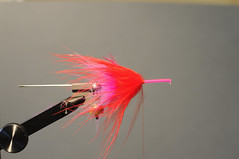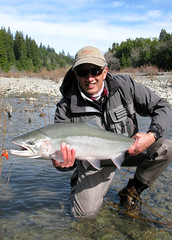When some people mention Skagit lines, the first thing that comes to mind are heavy sink-tips, big flies, and winter steelhead. This is true, and was the only way I thought of Skagit lines until the last couple of years. Skagit lines are a great fishing tool on both Spey and switch rods and more people than ever before are using them year round.
I myself, have gravitated towards Skagit lines for almost all my steelheading be it spring, summer, fall, and winter. In the summer and fall months I just swap my sink-tips for a floating tip and 12-15' tapered leader and am ready to fish. Part of the reason for fishing these lines in the summer and fall months has to do with the number of anglers and pressure many of our steelhead rivers now see. I have had to learn and fish new water to try and escape some of the pressure "traditional" runs and riffles see throughout a given day. I find myself fish smaller, tighter spots that don't allow much backcasting room, forcing one to get the fly out there with a very limited to almost non existent back cast. The shorter, quicker load of a skagit line allows one to do this. The second major factor has to do with guiding first time Spey casters into steelhead. Skagit lines allow one to learn and understand the basics of the two-hand casting a hell of a lot quicker than any other line out there. What once cold have taken two weeks for one to learn a single cast, now only takes an hour or less. It simply allows many of guides to guide their clients into fish a lot quicker and easier.
The last couple of years have seen tremendous growth in the spey fishing world. More and more anglers are getting into the two handed sport which has placed an emphasis on technology, teaching, guiding, and fishing. Learning to spey cast with a two handed rod is now easier than ever. When I first started spey casting we were using 14-15' 9 and 10 weights with Windcutter lines. It took me nearly a month to feel confident enough to tie and fly on and fish a run without have to worry about hooking myself in the neck. Not that these outfits were bad, they just took a lot more skill and practice to learn the spey casts. As Spey casting grew, so did rod and line technology.
In the last 5-6 years we are seeing a growth in the use of the Skagit lines. There is a big reason for this, Skagit lines make casting and fishing two handed rods much easier and more enjoyable. Skagit lines were designed by the likes of Ed Ward, Mike McCune, and Scott O'Donnell on the banks of the Skagit/Sauk rivers while trying to find a line that was able to cast big flies on heavy sink tips. Little did they know, that the design of this line would make a huge impact in the world of steelhead fishing.
Rio was one of the first company to design a Skagit taper. These lines were 27' in length and varied in grain weight, 350, 450, 550, and 650 grains. Soon there was a demand for more lines and Rio introduced more lines varying in 50 grain increments. Not long after,
Airflo and
Scientific Anglers followed suit and Skagit lines gained in popularity.
While many of these lines were great for the 13'6"-15' rods, many were having to modify lines to match some of newer, shorter, lighter Spey rods on the market. In the last couple of years, manufacturers have begun to design Skagits that were better suited to today's shorter lighter rods.
Airflo was the first company to introduce a line of Skagits designed to match almost any Spey/switch rod starting at 360 grain @ 22.5' and going up to 720 grains @ 28.5'. Soon
Beulah followed with the Tonic that ranges from 22.5 - 27' and match switch rods as light as 5/6 up to 9 weight spey rods. At the same time
Rio launched their line of Skagit Shorts designed for switch and small spey rods. Rio's Skagit Short range from 275 grains to 525 grains and are 20' in length. As the popularity of Airflo's Compact Skagit grew, Rio soon followed suit with their new Skagit Flight than range from 425 grains @ 24'to 750 grains @ 31'. Now there are almost too many choices out there for an angler to choose from. This just shows the growth and popularity and Skagit and Spey casting.
While there are many options out there to choose from, it is extremely important to make sure you get the proper line for your Spey/switch rods. The other thing to remember is that not all line recommendations will work for you. Many anglers prefer different loads in their rod while casting. Some prefer a heavier, deeper load(more grains), while others like a lighter load(less grains) and cast more off the tip. If you have had any two-hand casting experience, you should have an idea which you might prefer. That being said, if you are a beginner and have not spent any time with a two-handed rod, it is best to get a recommendation from a reliable source and go with a line that is "middle of the road" as far as grain weight it concerned. Many fly shops have employees that Spey fish and can give an angler a good line recommendation. There is also a decent amount of god info on the internet but be careful not to always listen to the internet experts, aka(speypages forums). Shops such as
Kiene's Fly Shop have some excellent and knowledgeable Spey information and can provide the correct Skagit line recommendations.
JH

















